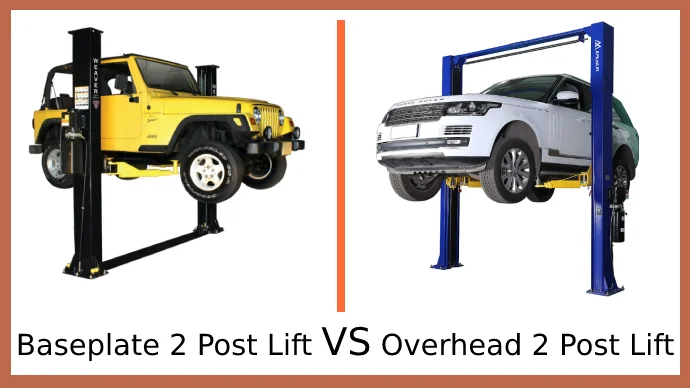Last Updated on June 21, 2023
An auto lift is one of the essential pieces of equipment in any garage. Although car lifts come in many different shapes and sizes, two popular types are the overhead two-post car lift and the 2-post baseplate car lift.
Both offer unique abilities and superior strength and provide a stable platform for work. But how do they differ?
With a higher rated capacity, the Overhead two-post car lift offers less lifting height but more stability due to its overhead support bar. In contrast, the Baseplate 2-post lift offers a higher lifting height but lower stability.
Whether you are a professional mechanic or a DIY enthusiast, choosing the right two-post car lift is crucial for a safe and efficient vehicle maintenance experience.
Read on to gain a more in-depth understanding of the differences between baseplate & overhead 2-post car lifts and determine which suits your needs.
Baseplate VS Overhead 2 Post Lift: Know the Differences
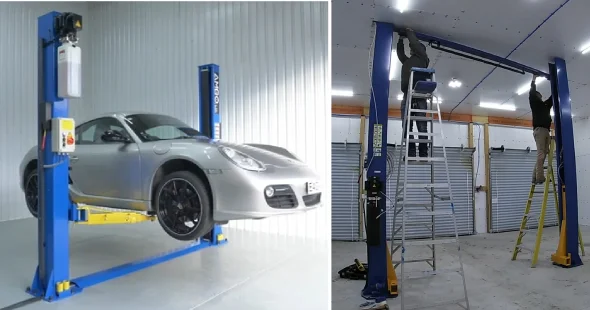
Two-post car lifts are a popular choice among automotive repair shops and home garages, as these lifts provide a safe and reliable way to raise vehicles off the ground. There are two main types of two-post car lifts:
- Overhead (AKA Clear floor) two-post car lifts and
- Baseplate (AKA Floor-plate) two-post car lifts.
Even though each car lift has its features, there are a lot of differences between them, like:
Lifting Height
When it comes to lifting height, the overhead two-post car lift typically offers less due to its overhead support bar than what the baseplate two-post lift does.
The baseplate lift is designed for extra clearance to get underneath taller vehicles without any issues. Its design allows technicians better access to components due to its higher lifting height capability.
Conversely, the overhead two-post lift is more suitable for general maintenance on most cars since its maximum height is lower than that of a baseplate lift.
Lifting Stability
Regarding stability, the overhead two-post automotive lift offers more than what the baseplate two-post lift does.
The overhead model is supported by its posts and the overhead support bar, giving it greater stability when lifting heavier vehicles or working with them at maximum heights.
It also has a higher resistance to tipping or overturning due to its sturdier construction compared to the baseplate model, which isn’t supported, as well as an overhead unit for heavier loads or when working at full extension lengthwise.
Lifting Ground Clearance
The baseplate two-post lift offers any automotive lift’s most advantageous ground clearance because of its maximum lifting height capability. This ensures that even the tallest vehicles can be set on the lift without requiring extra ramps or jacks.
Consequently, it provides a greater range of services for maintenance-related work and allows for easier access to undercarriage components.
Incomparable to an overhead system, the remarkable ground clearance offered through the baseplate two-post lift undeniably makes it the go-to tool for those requiring reliable and dependable tall vehicle access.
Lifting Arm Length
Baseplate 2 post lifts have a more extended reach than overhead two post lifts because they do not rely on an overhead bar for support.
With an overhead 2 post lift, due to the restrictions imposed by the overhead bar, the arms will not reach as far down as those on a baseplate 2 post lift would be able to reach. This can limit what types of vehicles can be properly serviced with an overhead 2-post lift, while it won’t be as much of an issue with a baseplate one.
Floor Requirements
The installation process for both types of lifts is quite different. A baseplate two-post lift requires bolting down into concrete or other solid surfaces. In contrast, an overhead two-post may not require any specific flooring material, although it requires more ceiling height than a baseplate lift.
Require Ceiling Height
Another significant difference between baseplate and overhead 2 post lifts is their required ceiling height. Baseplate lifts typically require a lower ceiling height than traditional overhead 2-post lifts due to their design structure.
An overhead lift requires at least 12 feet of clearance to operate properly, but a baseplate lift can typically fit in as little as 8-10 feet of clearance from the floor to the ceiling. This makes a baseplate two-post lift much more suitable for shops with low headroom or limited space.
Vehicle Under Accessibility:
The last significant difference between these two types of two-post vehicle lifting systems is the vehicle under accessibility. This has much to do with how vehicle doors open using each type of system.
Some baseplate lift systems use a double 4-point contact plate positioned beneath the car. This plate is designed to fit snugly against the lower part of the vehicle frame, and it offers excellent accessibility when performing repairs or inspections on specific components located underneath the vehicle.
Overhead 2 post lifts offer an even greater level of accessibility due to their two independently adjustable arms that can be extended outward to reach further underneath the car. The arms also provide extra stability during lifting, making them better suited for certain heavier vehicles such as SUVs or trucks.
2 Post Car Lift Overhead or Floor Plate, Which is Best for Larger or Heavier Vehicles?
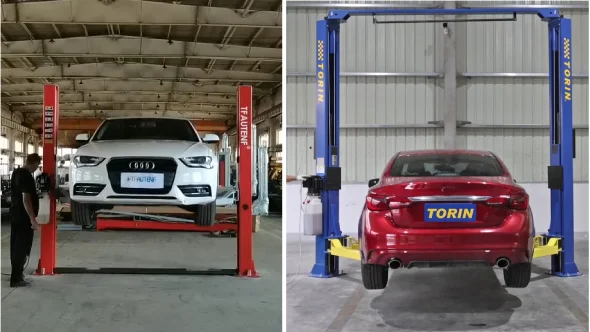
The overhead two-post car lift is the preferred choice when lifting larger or heavier vehicles due to its superior lifting capacity and stability. With up to five tons of lifting capabilities, this lift can securely handle even the heaviest vehicles.
Furthermore, this lift’s precision-engineered design features an overhead beam that provides additional strength and stability, helping prevent tipping during loading and unloading.
These overhead models are designed specifically for larger or heavier vehicles. It provides greater stability due to its increased vertical clearance, making it much easier to use when working on tall or raised suspension components and large tires and rims found on heavy-duty pickup trucks and SUVs.
Which Type of 2-Post Car Lift is Best for a Home Garage?
Several essential factors must be considered when choosing the best two-post car lift for a home garage, such as:
- The size of the vehicle being worked on should be considered. If a person is working on larger vehicles such as trucks or SUVs, they will need a lift with greater capacity.
- Consider what work is being done in the home garage. If someone just needs to change oil and rotate tires, they may not need a high-capacity lift, but if they are doing more extensive work such as brake jobs or engine rebuilds, a higher-capacity lift becomes much more critical.
- Safety should always be a top priority when working on vehicles in a home garage. A light-duty two-post lift may be fine for light tasks, but heavier-duty lifts will provide excellent stability and safety for more involved repair jobs.
No matter which type of 2-post auto lift someone chooses for their home garage. It is important to ensure that the unit meets all applicable safety standards and that proper installation procedures follow manufacturer guidelines.
Can an Overhead Lift be Used in a Workshop With a Low Ceiling?
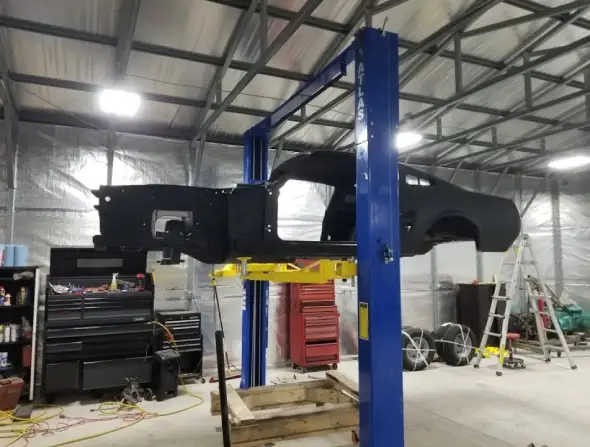
An overhead 2-post car lift cannot be used in a workshop with a low ceiling. The ceiling’s overall height must be at least 12 feet for an overhead lift to function properly. This is because the lift needs enough clearance to raise and lower vehicles without being blocked by the ceiling.
Aside from that, this requirement is determined by safety standards by organizations like ANSI/ALI ALIS, ANSI/ASME PALD, and SAE J778. These organizations are responsible for developing and enforcing safety standards for lifts, hoists, and other shop equipment to ensure they work safely.
Therefore, anyone considering installing an overhead 2-post car lift should ensure that their workshop has at least 12 feet of clearance before attempting to do so.
Is There a Difference Between Installing a 2 Post Lift Floor Plate and an Overhead Lift?
There is a huge difference between installing a floor plate 2 post-car lift and an overhead auto lift.
An overhead bar must be installed between the overhead car lift two posts so that it can be used as a bearing for the lifting arms. This support bar must be securely attached to the posts and reinforced with brackets to properly hold the car’s weight while being raised.
With a floor plate car 2-post lift, there is no need to install extra equipment, such as an overhead bar or bracing system. Instead, the two posts are bolted to the ground and connected with a base plate and lifting arms. This makes installation much easier as no extra drilling or cutting is required.
Also, depending on how tall your ceilings are, an overhead hoist may reach higher than a baseplate 2 post system, which gives you better flexibility when working with different heights of vehicles.
Are There Any Safety Features Included With an Overhead 2-post Car Lift?
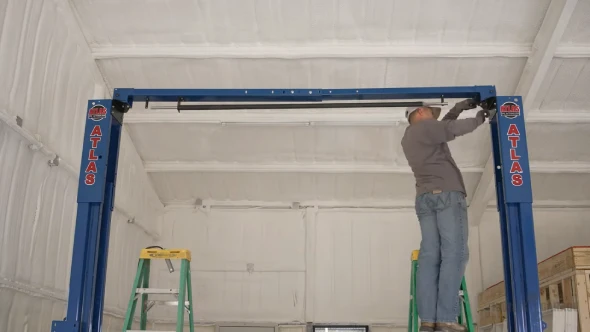
An overhead 2-post auto lift should be used with extreme caution, as they involve the potential for injury if not operated properly. Fortunately, some features built into overhead 2-post car lifts can help ensure the operator’s and the vehicle’s safety.
The first safety feature found on most overhead 2-post car lifts is an overhead support bar. This bar is designed to provide additional stability when lifting a vehicle or when another weight is applied to the lift arms. The support bar also helps to ensure that any load lifted does not tip or become unstable during operation.
Also, many models will feature padded safety bars, which are designed to help protect both the operator and their equipment from potential damage should an unexpected event occur while working on a vehicle.
Baseplate or Overhead 2 Post Car Lift: Which One is Perfect for You?
Both overhead two-post and 2-post baseplate car lifts offer their advantages in automotive work. The overhead two-post car lift offers less lifting height but more stability than its 2-post baseplate counterpart, perfect for people who need extra support or prefer not to have their vehicles elevated too high off the ground.
Those who require a greater amount of lifting height may find better utility in a 2-post baseplate car lift since it has been rated with higher capacities than most other traditional lifts. Before investing in this type of equipment, make sure you look into all the options.
